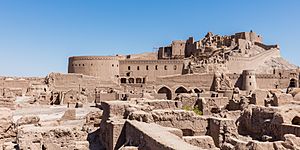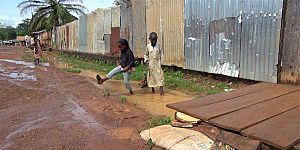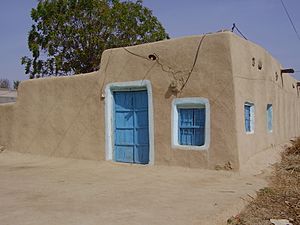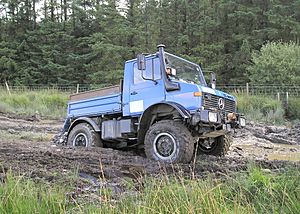Mud facts for kids
Mud is a squishy mix of water and different kinds of soil, like loam, silt, and clay. It often forms after it rains or near rivers and lakes. Over a very long time, old mud can turn into sedimentary rocks like shale or mudstone. When mud builds up in places where rivers meet the sea (called estuaries), it forms layers known as bay muds.
Contents
Building with Mud

Mud as a Building Material
For thousands of years, people have used mud to build homes and other structures. Mud can be mixed with water and other things like stones, gravel, or straw. This mix can be used to make walls, floors, and even roofs.
Many old buildings around the world have walls made from mudbricks. Other ways to build with mud include wattle and daub, rammed earth, or cob techniques. Often, these mud surfaces were covered with earthen plaster to make them smooth.
Mudbricks (Adobe)

You can make mud into mudbricks, also called adobe, by mixing mud with water. This mixture is then put into special shapes or moulds. After that, the bricks are left to dry in the open air. Sometimes, straw is added to the mud. The straw acts like a support system, making the bricks stronger and less likely to break.
Buildings made of mudbricks need protection from water. They are usually built on foundations of stone or fired brick to keep them safe from ground water. In rainy places, deep roof overhangs help protect the walls from rain. In very dry places, a flat roof can be covered with a special mud coating. This mud expands when it gets wet, making it more waterproof. The Pueblo Indians often used adobe mudbricks to build their homes.
Fired Bricks
If mud has a lot of clay in it, or is a mix of clay and sand, it can be used to make ceramics. One common ceramic is the fired brick. Fired bricks are much stronger and last longer than mudbricks. However, they need a lot of energy to be made because they are heated to very high temperatures in a kiln.
Stabilized Mud
Sometimes, builders add things like cement or bitumen to mud. This makes the mud stronger and more stable. This type of mud is called stabilized mud. Examples include mudcrete and soil cement.
Making Pottery
Pottery is made by shaping a special kind of mud, called a clay body, into different objects. These objects are then heated to very high temperatures in a kiln. This heating process removes all the water from the clay. It also causes changes that make the pottery strong, hard, and keep its shape forever.
Before shaping, the clay needs to be prepared. Kneading the clay helps make sure it has the same amount of moisture all over. Any air trapped inside the clay needs to be removed. This is called de-airing. It can be done with a machine called a vacuum pug or by hand using a method called wedging. Wedging also helps to make the moisture even. Once the clay is ready, it can be shaped using many different techniques. After shaping, it is dried and then fired.
In pottery, liquid mud is called slip. This is used to refine materials, as larger particles will sink to the bottom of the liquid.
Mud as a Home
For Land Animals
Mud can be a home for many animals. This includes different kinds of worms, frogs, snails, clams, and crayfish. Other animals, like hippopotamuses, pigs, rhinoceroses, water buffalo, and elephants, love to roll around in mud. They do this to cool down and to protect their skin from the sun. Mud that is underwater can also be home to the larvae (young forms) of many insects.
For Sea Creatures
Mud is very important in the marine ecosystem (the ocean environment). Animals and fish that burrow into the muddy seabed stir it up. This helps oxygen, nutrients, and minerals move between the water and the sediment (the mud at the bottom).
Below the surface, some animals dig complex tunnels that can go a meter or more deep. These muddy burrows are rich habitats. They provide food and shelter for many creatures that live in the mud, as well as other animals that search for food there.
Problems with Mud
Heavy rain or melting snow can make the ground very wet. This can cause the soil or mud to move suddenly. This movement can lead to mudslides, landslides, or even avalanches of mud and rocks.
Mudslides that happen in areas with volcanoes are called lahars. These occur after a volcanic eruption when rain washes away loose ash deposits.
Recreation with Mud
Mud Bath
A mud bath is when people bathe in mud. This mud often comes from places where hot spring water mixes with volcanic ash. Mud baths have been around for thousands of years. Today, you can find them in fancy spas in many countries.
Mud Wallow
Mud wallows are a fun place for kids to play. A mud wallow can be any shape, size, or depth. It's usually a shallow dip in the ground that has filled with water and dirt, creating squishy mud.
Mud Bogging
Mud bogging is a type of off-road sport. It's popular in Canada and the United States. The goal is to drive a vehicle through a pit of mud or a muddy track. The winner is usually the one who travels the farthest through the mud. If several vehicles make it all the way, the fastest time wins.
Mud Run
Mud runs are another popular activity involving mud. Participants run a distance, usually from 3 to 10 miles. Along the way, they have to crawl through muddy pits and overcome other obstacles.
Other Mud Fun
- Dirt biking involves riding bikes on muddy tracks and courses.
- Baseball Rubbing Mud is a special mud used to remove the shine from new baseballs.
- Children often enjoy making 'mud pies', throwing mud at each other, or playing barefoot and covering their feet and bodies in mud.
Images for kids
-
Vehicle in mud after heavy rainfall (Democratic Republic of the Congo)
-
Mud was a big problem in the famous Battle of Passchendaele in 1917
See also
 In Spanish: Barro para niños
In Spanish: Barro para niños











